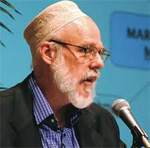The Islamic Tartan Endorsements
Muslim Council of Scotland
Statement in Support of Islamic Tartan Project

Interaction between Scotland and the Muslim world stretches to over 500 years, with notable individuals including; Michael Scot of Melrose whose translations of the philosophical works of Ibn Rushd were instrumental towards inspiring the Renaissance, John Yahya Parkinson of Kilwinning whose poetry honoured the Prophet Muhammad (SAW) and Lady Evelyn Cobbold, the first British woman to make the pilgrimage to Mecca.
With such a rich history, Muslims are today recognised as one of the most diverse and vibrant communities, representing an integral part of the tartan fabric of Scotland.
Muslim Council of Scotland is therefore delighted to support the Scottish Islamic Tartan which celebrates the diverse Muslim identities by weaving them together into the tartan of Scotland. We also wish Dr Azeem Ibrahim well, and pray this timely project successfully achieves its objectives.
Setting a New Course
Shaikh Hamza Yusuf - Mark Hanson, Co Founder Zaytuna College

As Scotland's young people build community, trust and understanding, the search for symbols becomes an important shorthand for the fusion of their aspirations, ambitions and dreams. What better symbol than the Scottish Islamic Tartan, a cloth woven of different elements of Islam in the tradition of a country proud of its independent thinking, its tolerance and enlightenment.
As societies mobilize their moral, spiritual and social resources to respond to the problems of our age, Scottish Muslims are indeed setting a new course for relations in the 21st
Return of the Tartan
Imam Zaid Shakir, Zaytuna College

One of the great world cultural traditions is the Scottish Tartan. The colours and patterns of the clothe found in kilts and other articles convey deep meanings and constitute an integral part of a rich heritage. Like a Coat-of-Arms, it helps to demarcate clans and tribes and signifies their distinctions. Sadly, if the number of mills producing authentic tartans is any indication, we can safely say the tartan and the tradition it represents is being threatened.
It is context that makes the initiative of Dr. Azeem Ibrahim so compelling. By introducing the Islamic tartan, Dr. Ibrahim is not only providing a solid basis for helping to indigenize Islam in Scotland, he is also helping to preserve a valuable cultural tradition. Such an effort must not only be lauded for its deep cultural and historical implications, it must also be supported.
A Powerful Symbol
Dr. Umar F. Abd-Allah Wymann-Landgraf, Darul Qasim

In a world where events tend to drive nations and communities apart, the Islamic Tartan Project is a powerful and timely symbol of dynamically merging traditions and cultures. My own Scottish heritage, being of the Armstrong highlander clan on my father's mother's side, makes me deeply aware of the tartan's significance in Scotland's history, representing community, integrity and independence of spirit.
The Scottish Enlightenment with its intellectual freedoms has informed my studies and thinking, just as have the great thinkers and philosophers in the Islamic world. A renaissance of Islamic scholarship is enriching the Western world again, building on traditions of the Scottish philosophers and others, and creating a synergy that will lead to a greater understanding among nations.
A blending of intellectual traditions is fittingly symbolized in the blending of cultures in the visual symbol of a tartan. Dr Ibrahim's initiative is to be applauded for its vision, its powerful cultural symbolism and its significance for the Scottish Muslim community.
Faith and Culture
Shaykh Amer Jamil, Solas Foundation

When my old friend Dr. Azeem Ibrahim first introduced the idea of the Islamic tartan to me I was astonished to find that one did not already exist. For me as a devout Muslim brought up in Scotland, the Islamic tartan represents two aspects of my identity; my faith and my culture. It symbolises the celebration of both the presence and contribution of the Muslim community in modern day Scotland which has its origins over a long period of time. Today it is an ever present reality with the Muslim community representing the 2nd largest faith in Scotland after Christianity.
A sense of belonging is extremely important to community cohesiveness and contribution to society. With the Islamic tartan Muslims in Scotland will now be able to outwardly express two parts of their identity; their Islamic faith and Scottish culture.
I welcome this initiative and would like thank Dr. Azeem for initiating this positive project for the current Muslims across Scotland, and for the generations to come.
Power of Icon
Shaikh Ruzwan Mohammad, Solas Foundation

Across the world, Scottish tartan has been synonymous with the spirit of enquiry and enlightenment. From the medieval period to the present day, this spirit was embodied in the constant stream of luminaries who travelled from its shores to the newly founded colleges of Europe, many of which were based on the famous scholastic colleges in the Muslim world. The intellectual legacy these Scots left behind continues to shape the world we know today.
In my own experience of traveling the world, the tartan has been one of the few national symbols that has managed to surpass it's own borders and, like the fervently independent minds that emigrated from its shores, it has informed all our collective memories.
In a world where the power of icon and symbolism have become ever more potent, this initiative by Dr Ibrahim is both inspired and needed.
Inspired because it is in keeping with the aspirations of a new generation of Muslims in Scotland who's own unique sense of identity and belonging is waiting to be expressed. The design of the Islamic tartan gives expression to this identity, incorporating the motif of the Muslim Sacred house or Ka'bah which represents the primordial faith, while the emblematic Scots blue gives temporal context to that faith. It is needed because, just as the tartan weave is made up of distinct hues and colors that merge to create a unified whole, this tartan gives a visual voice to the conviction that there are far more things that bring us together than draw us apart.